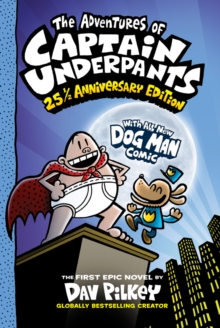
Dav Pilkey: How His ADHD and Dyslexia Shaped the Dog Man Movie and Comic Empire
Share
Dav Pilkey’s Journey as a Dyslexic, ADHDer: How He Built a Comic Empire with Dog Man, Captain Underpants & Cat Kid Comics
Dav Pilkey, the creative genius behind the globally beloved Dog Man, Captain Underpants, and the Cat Kid series, has captivated millions of readers with his humor and imagination. His personal story — being a dyslexic, ADHDer — has played a pivotal role in shaping his unique storytelling style. At MAKES SENSE TO ME, we believe that neurodivergent traits are human traits and that embracing those differences is the key to fostering creativity and success. Pilkey’s journey underscores the importance of rejecting neurotypical standards and the limits they place on neurodivergent individuals.
 Growing Up Dyslexic with Unidentified ADHD: Pilkey’s Early Struggles
Growing Up Dyslexic with Unidentified ADHD: Pilkey’s Early Struggles
Growing up dyslexic with unidentified ADHD, Pilkey faced significant difficulties in traditional educational systems. Reflecting on his school days, he recalls, "I had a hard time focusing, but I didn't want to be separated from my friends. I didn't want to be known as that kid who couldn't sit still, or the troublemaker and slow reader" (Pilkey, 2022)¹.
Sadly, this story is not unique. Far too often, neurodivergent children are forced to fit into a neurotypical framework that devalues their natural ways of thinking. This approach overlooks and devalues neurodivergent individuals, creating unnecessary barriers that disrupt potential. By squeezing neurodivergent children into these restrictive molds, society suppresses the unique perspectives and talents they can offer. Pilkey’s success story proves that these “challenges” can, in fact, become the very source of greatness.
Isolated in the hallway due to his disruptive behavior, Pilkey began drawing, which led to the creation of characters like Captain Underpants, Dog Man, and later, the Cat Kid series. As Pilkey explains, "Dog Man is kind of like me when I was ... . Sometimes I got myself in trouble..." (Pilkey, 2022)². The power of embracing his dyslexia and ADHD became clear: they were key to his creativity, not obstacles to his success.



The Power of ADHD and Dyslexia: Creativity and Imagination
Research indicates that individuals with ADHD often display higher levels of creativity. Studies show that ADHD can enhance conceptual expansion and originality, as individuals with this condition often think outside the box (Scientific American, 2022)³. For Pilkey, his ADHD and dyslexia did not hinder his success — they shaped it.
The visual and imaginative nature of ADHD and dyslexia helped Pilkey excel in creating complex comic worlds. The Dog Man series, known for its witty humor and vivid illustrations, has sold over 60 million copies globally and been translated into 47 languages (Scholastic, 2022)⁴. His ability to bring these vibrant, creative worlds to life has led the Dog Man series to become a global sensation, with demand for new books and merchandise growing exponentially (The Popverse, 2022)⁵.
Pilkey’s Cat Kid series, which debuted in 2020, has similarly captivated audiences with its humorous and heartwarming stories. Like Dog Man, Cat Kid is a delightful blend of fun, action, and visual storytelling. The success of Cat Kid proves that Pilkey’s unique storytelling style, informed by his dyslexia and ADHD, resonates with readers of all ages. Both Dog Man and Cat Kid have solidified Pilkey’s place as a leader in the world of graphic novels and comics.
Doodling, a common behavior among individuals with ADHD, can be considered a form of stimming — a repetitive physical activity that provides sensory input. Stimming plays an essential role in emotional regulation, helping individuals with ADHD and dyslexia focus, release excess energy, and calm their emotions. For Pilkey, doodling while isolated in the hallway was not just a means of passing time but an outlet for emotional expression and a way to concentrate. Through this form of self-regulation, he tapped into his creativity and developed some of the most beloved characters in modern literature.
Stimming can act as a tool for focusing on tasks, enhancing problem-solving abilities, and managing overwhelming emotions. This is why creative outlets like doodling are often seen as powerful tools for neurodivergent individuals, allowing them to harness their energy and transform it into something productive and imaginative.
How ADHD and Dyslexia Led to Pilkey’s Success
At MAKES SENSE TO ME, we believe that the challenges faced by neurodivergent individuals should not be framed as “deficits” but as opportunities for growth, creativity, and innovation. Society’s tendency to enforce neurotypical standards creates unnecessary barriers that hinder neurodivergent individuals from reaching their potential. Pilkey’s success story is a shining example of what happens when these barriers are removed.
Pilkey’s journey is proof that we must stop trying to force neurodivergent individuals to fit a mold that doesn’t work for them. Instead, we should provide spaces where they can thrive — where neurodivergent traits, such as creativity, imaginative thinking, and emotional regulation, are celebrated. Pilkey's work continues to inspire millions of children, showing that embracing neurodivergent traits can lead to incredible success in any field.
In Pilkey's own words, "Reading can be like running a marathon for people with dyslexia" (Pilkey, 2022)¹. This resonates deeply with many young readers who may struggle with reading but find solace in the world of Dog Man, Captain Underpants, and Cat Kid. Comics, with their combination of visual storytelling and simplified text, offer a fantastic, accessible format compared to traditional novels. For many neurodivergent individuals, especially those who are visual thinkers, graphic novels make perfect sense as they align with their natural way of processing information. Dav Pilkey's success with this format speaks to the power of comics as a tool for engagement and learning. MAKES SENSE TO ME offers a curated selection of picture books, graphic novels, and comics for this reason — to support neurodivergent readers and provide content that resonates with their unique ways of processing and experiencing the world.

![]() The Release of the Dog Man Movie: Celebrating Neurodiversity in Entertainment
The Release of the Dog Man Movie: Celebrating Neurodiversity in Entertainment
As the Dog Man movie releases today, we celebrate the creativity of Dav Pilkey and the positive impact of neurodiversity in literature and entertainment. By embracing neurodivergence and rejecting the expectation that everyone must conform to neurotypical standards, we create richer, more inclusive stories that resonate with readers of all abilities. The film’s release is an exciting milestone for Pilkey's growing empire and for children who see themselves reflected in his characters.
At MAKES SENSE TO ME, we are dedicated to supporting and promoting books that encourage neurodivergent readers to embrace their unique abilities. The Dog Man series is an incredible example of how ADHD and dyslexia can serve as catalysts for creativity, storytelling, and success. When we stop placing unnecessary barriers in the way of neurodivergent individuals and embrace their unique ways of thinking, we open the door to limitless possibilities.
Find Dav Pilkey's full collection of books HERE
Sources
- Pilkey, D. (2022). Dav Pilkey on Dog Man: Parents should let kids pick the books they want to read. The Times.
- Pilkey, D. (2022). Interview with Dav Pilkey: The inspiration behind Dog Man and Captain Underpants. Scholastic.
- Scientific American. (2022). The creativity of ADHD. Scientific American.
- Scholastic. (2022). Dav Pilkey’s Dog Man: A global sensation. Scholastic Media Room.
- The Popverse. (2022). Dog Man is the best-selling book around the world right now with demand growing for Dav Pilkey’s canine hero. The Popverse.










